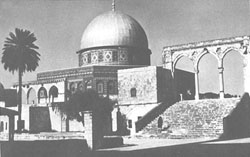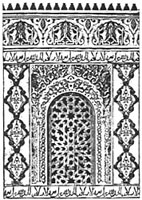|
medical work is called "On the Plague." Al-Maglusi, in the book, Kitabu'l Maliki showed a rudimentary conception of the capillary system,31 and an Arab from Syria, Ibn al Nafis, discovered the fundamental principles of pulmonary circulation.32 Camphor, cloves, myrrh, syrups, juleps, and rose water were stocked in Arab "sydaliyahs" (pharmacies) both in the East and in Europe centuries ago. Herbal medicine was widely practiced, and basil, oregano, thyme, fennel, anise, licorice, coriander, rosemary, nutmeg, and cinnamon found their way through Arab pharmacies to western tables. Architecture As in astronomy and mathematics, the great purpose in Islamic architec�ture was to glorify the Faith, and Muslim builders devoted their skills to the building of mosques and mausoleums. They took over the horseshoe arch from the Romans, developed it to their own unique style, and made it an example for the architecture of the West. The Great Mosque of Damascus, built in the early eighth century, was a beautiful demonstration of the use of the horseshoe arch, and the Mosque of Ibn Tulun in Cairo, with its pointed arches, was the inspiration to medieval French, German and Italian architects in the building of the magnificent Cathedrals of Europe. Cusped, trefoil and ogee arches provided the models for the Tudor arch such as those used in the cathedrals of Wells in England and Chartres in France.33 The Muslim minaret, itself inspired by the Greek light-house, became the campanile in Europe, one of the most famous examples being seen in the San Marcus Square in Venice.34 Designs from the Islamic Mosques of Jerusalem, Mecca, Tripoli, Cairo, Damascus and Constantinople were borrowed in the building of ribbed vaults,
The Dome of the Rock in Jerusalem, built in 691 A.D., is the earliest example of Islamic architecture on a grand scale. Details of a window of the Alhambra, Granada.
| |||

